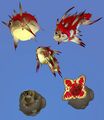Crashfish (Subnautica)
Template:Infobox:Fauna Flora The Crash is a life form belonging to the fauna category. It can be found in caves, most of the time in Safe Shallows Caves.
The Crash usually resides inside a plant which looks like a black round rock when the player isn't spotted. Crash Powder can be found inside the base.
Appearance
The Crash is a round and oval shaped fish with a wide mouth and one eye with a large black pupil in front. It has spikes on its back and sides that align backwards when it swims forward and are directed out when it feels threatened. It has a distinctive red color on its back with white spots on the sides. Its mouth and underside are colored white.
The plant itself is dome-shaped when closed, with little room between the four rounded petals. When the plant opens up and releases the Crash, it also reveals the fleshy-looking interior of the plant. The exterior of the plant is black, while the inside is mostly pink with a light yellow line at the edges.
Behavior
When the player gets too close, the Crash plant opens up like a flower and will emit a kind of gurgle, revealing the Crash inside.
If the player comes too close, the Crash will charge the player while emitting a specific, easily-recognizable noise. After a short amount of time, the Crash will explode, causing damage to the player, the Seamoth and the vicinity. If the Crash explodes next to a Seamoth that the player is in, it usually destroys the Seamoth.
The Crash is as fast as the player, even with fins equipped. Therefore, it is quite hard to escape the Crash until the player has better fins. The Crash plant can usually be killed with a Survival Knife and will produce other Crashes over time if not killed. Crashes take 15-20 minutes to respawn inside their base after exploding.
The best tactic to kill the plant is to get out of the Seamoth, trigger the ejection, evade, and after the explosion of the Crash, collect the Crash Powder and destroy it with the Survival Knife. Or use the upgraded Repulsion Cannon to push them against a wall, causing them to explode. Additionally, one can use a Stasis Rifle to immobilize it. The Crash will still explode, even while in stasis, so this is ideal to control the detonation and stay out of the blast radius.
Data Bank Entry
Crash
- Impact-sensitive spikes: If the lifeform collides with something at sufficient speed these spikes are impacted, triggering an internal chemical reaction.
- Suction snout: Likely adapted to vacuum up small insects and grubs in cave systems.
- Chemical storage organ: concentrations of sulfur build up in this organ over time, and can be deployed as an explosive last line of defense during the nesting phase.
Data points to an evolved symbiosis with the crash plant. Hypothesis: the plant evolved to feed on sulphuric compounds secreted by the Crash. Stronger, more protective plants provided superior nesting grounds, which in turn benefited the plant with more nutrients, and the co-operative cycle continued.
Assessment: Avoid or incapacitate
Crash Plant
This plant species appears to share a symbiotic relationship with the aquatic lifeform that nests inside it. The petal-like structures appear undamaged when the lifeform emerges, and likely remain open until the nest is reclaimed by the original owner, or another.
Further information on this relationship is not possible from studying the plant in isolation.
Trace amounts of a sulphuric residue have been detected on the inner leaves.
Assessment: Exploitable
Gallery
Crash data on the PDA
For a more completed gallery, visit Crash/Gallery.






